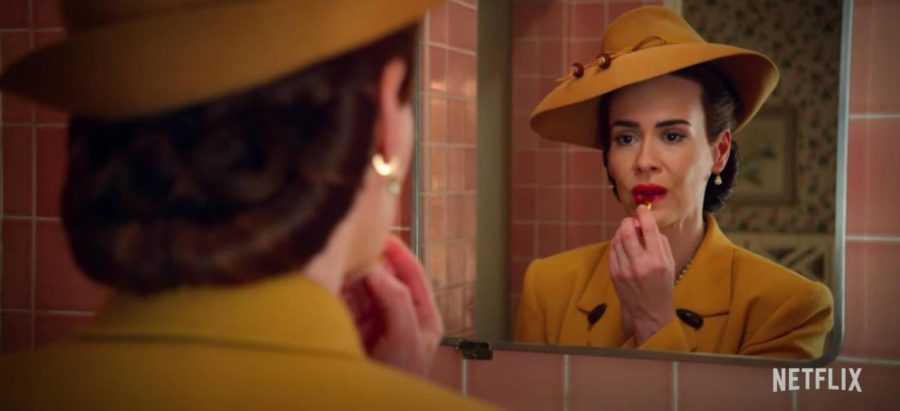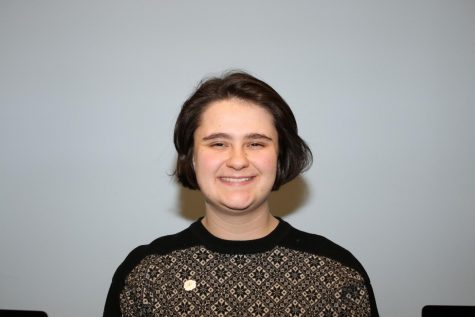“Ratched”: A Mixed Bag of Cuckoos
Witness the origin story of the infamous Nurse Ratched.
October 2, 2020
Disclaimer: Review contains spoilers
“I believe there are some things that are worse to feel than simply feeling nothing,” says Nurse Ratched in Netflix’s new series “Ratched.” Creepy in the context of affirming lobotomies, this quote also offers insight on how she views mental illness, trauma and sexuality in this fresh take on a notoriously evil nurse.
Based on Ken Kesey’s 1962 novel “One Flew Over the Cuckoo’s Nest,” “Ratched” is a prequel, telling the beginnings of antagonist, Nurse Mildred Ratched, at Lucia State Mental Hospital in Northern California. Although, to categorize her as an antagonist in this series would be inaccurate, as she falls into a morally gray area. Sarah Paulson brings an emotional depth—not to mention a killer wardrobe—to Kesey’s totalitarian head nurse. The story takes place in 1947 and succeeds in making her three dimensional, and even likable, as Director Ryan Murphy paints Ratched much more sympathetic than Kesey. However, it uses cliche and problematic character development, with repressed sexuality and sexual trauma in the obligatory backstory. “Ratched” is redeemable though, through Paulson’s stellar performance and ensemble female cast, making it worth a watch.
Murphy has a tendency to produce shows saturated with sexuality and gore, and “Ratched” is no different. For the weak-stomached, the gore is a bit gratuitous. However, sexuality is a central theme. The first time we are introduced to Ratched, she is irritated by a gas station employee who gets distracted by a couple making out. This discomfort around sexuality becomes more and more prevalent throughout the show.
There is palpable tension in the second episode when Gwendolyn Briggs (Cynthia Nixon), takes Ratched to an oyster bar. Murphy skips the queer-baiting prevalent in much of today’s media and dives head-first into lesbian overtones, with Briggs feeding an oyster to Ratched and saying “it’s like making love to the ocean.” Ratched is offended by Briggs’ advances and is not ready to admit to herself that she is attracted to women. This is problematic within the larger scope of LGBT+ characters often being villains, even if Paulson’s Ratched is not like Kesey’s heartless, tyrannical Ratched. That being said, it is powerful––and unfortunately uncommon––to have two actual queer women portraying lesbians on-screen. Nixon and Paulson add an authenticity and tangible longing that, although troublesome, fleshes Ratched out.
The characterization of Ratched is a bit uneven, as she is sometimes portrayed as a manipulative, cold nurse, who convinces patients to kill themselves and performs lobotomies outside the asylum. At other times, we see her as a woman willing to sacrifice everything for those she loves and someone deeply affected by sexual trauma from her childhood as well as her repressed sexual identity. While the show does not connect the two— childhood sexual trauma and lesbianism—it, unfortunately, does nothing to separate them. Trauma “causing” sexual orientation is another damaging trope that “Ratched” falls into. Again though, its problematic elements are offset by Paulson’s poignant performance, particularly the scene in which we learn about Ratched’s childhood and witness her emotional collapse. Paulson has a gift for portraying grief and emotional anguish — just see her accolades for her portrayal of Marcia Clark in “The People v. O. J. Simpson: American Crime Story” as proof.
Inconsistent characterization of the main character aside, “Ratched” is also noteworthy for its other female characters. It boasts both Sharon Stone and Judy Davis as Lenore Osgood and Nurse Betsy Bucket, respectively. These powerhouses both deliver memorable performances, with Stone acting as an eccentric, revenge-seeking heiress while Davis plays a grumpy but good-at-heart head nurse. They both give better performances and, frankly, have more interesting storylines than Finn Wittrock who plays Edmund Tolleson, a central character. Tolleson, an unstable serial killer and Ratched’s adoptive brother, spends most of the show housed at Lucia State Hospital. His story, like Ratched’s, is also saturated in sexuality, but it does not serve much of a purpose. When contrasted to Ratched, Tolleson’s sexuality brutalizes him, while Ratched’s sexuality humanizes her.
Overall, “Ratched” does suffer some flaws in its writing, but the show is enjoyable due to its acting performances, representation and brilliant use of light and wardrobe. Fun fact: Paulson wears a massive ring of keys around her arm as a callback to Louise Fletcher’s portrayal of Nurse Ratched in the 1975 film adaption of “One Flew Over the Cuckoo’s Nest.” These clever details help counterbalance the show’s other questionable elements. Murphy’s “Ratched” may not be like Kesey’s, but he tells a story that’s interesting enough on its own.
“Ratched” is streaming on Netflix.



